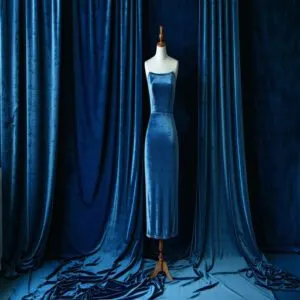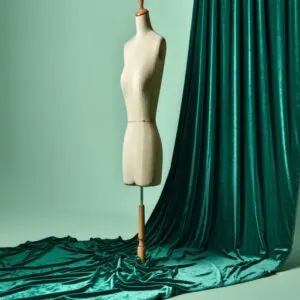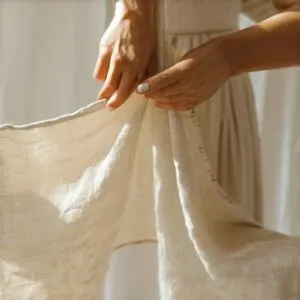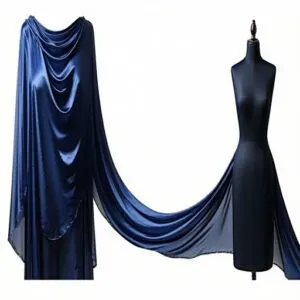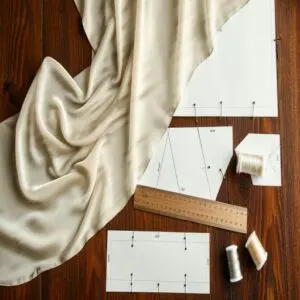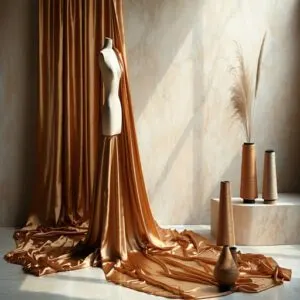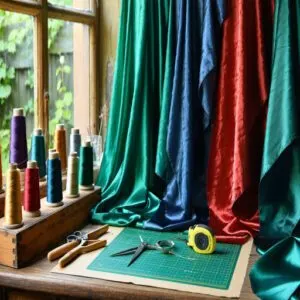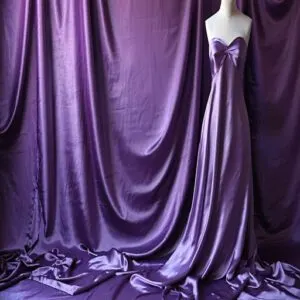This site is supported by our readers. We may earn a commission, at no cost to you, if you purchase through links.
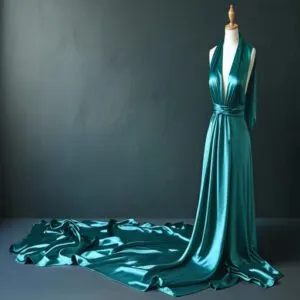
Grain refers to the thread direction: lengthwise (warp), which runs parallel to the selvage and is super stable, and crosswise (weft), which is more flexible.
Then there’s the bias—diagonal, stretchy, and dreamy for flowy drape.
Cutting along the correct grain guarantees your fabric behaves as planned.
Want that fabric to hang just right? Match your pattern pieces to the grainline! Pro tip: Check the selvage edge and give the fabric a stretch test to spot the grain direction.
Master this, and sewing magic awaits! ✂️
Table Of Contents
Key Takeaways
- Check the selvage edge to identify the fabric’s lengthwise grain; the lengthwise grain runs parallel and provides stability, while crosswise grain offers moderate stretch.
- Always align your pattern pieces with the grainline to ensure proper drape, fit, and strong, straight seams.
- Use the bias grain for maximum stretch and flowing drape in garments like dresses, but handle it carefully to avoid unintended stretching.
- Misaligned grain can cause distortion, poor fit, twisted seams, and even uneven shrinkage after washing—so test and adjust grain alignment before cutting to ensure proper drape.
Fabric Grain Basics
When you’re working with fabric, understanding its grain is like knowing the secret ingredient to a recipe—it makes everything better.
The grain’s direction affects how the fabric will stretch, drape, and behave, so let’s get you sewing smarter, not harder.
Warp and Weft Threads
Warp and weft threads are the building blocks of fabric stability.
Think of warp threads as the straight-laced type, running parallel to the grain direction.
Weft threads? They crisscross perpendicularly, adding flexibility.
Together, they create the fabric’s textile structure.
Missing this? It’s like baking without understanding ingredients—knowing warp and weft gives you control over weave patterns, and thread tension, and results!
Selvage Edges and Grain Direction
Look along the fabric edge for the selvage—it’s the tightly woven strip that won’t fray.
It helps you figure out the grain direction for perfect grain alignment.
Remember:
- Warp threads run parallel to the selvage.
- Fabric stretches least along this grain line.
- Selvage identification keeps you cutting smart, not guessing.
Spot these edges and you’re golden!
Types of Grain Lines
You know how the selvage shows the fabric’s structure?
Well, the magic unfolds with grain line variations: lengthwise grain runs stable like a straight-laced pal, crosswise grain offers flexibility for a comfy stretch, and bias grain?
That’s the stretchy, showy superstar!
Learn the grain direction game early—it’s your ticket to mastering sewing techniques and achieving perfect drape.
| Grain Line | Stretch Level | Stability | Best For | Sewing Impact |
|---|---|---|---|---|
| Lengthwise Grain | Least stretch | High | Structured garments | Strong seams |
| Crosswise Grain | Moderate stretch | Medium | Comfy, casual clothes | Some flexibility |
| Bias Grain | Maximum stretch | Low | Flowing, drapey styles | Careful handling |
Identifying Grain Direction
Identifying fabric grain isn’t as tricky as it sounds—it’s all about spotting clues like selvage edges, stretch direction, or how prints line up.
Once you’ve got the hang of it, your sewing projects will thank you for the perfect fit and fewer oops moments!
Visual Inspection Methods
Spotting fabric grain isn’t rocket science—it’s all about using visual cues.
Start by checking the selvage edges; they point out the lengthwise grain. Notice weave patterns or thread count differences that guide you to the grain line.
Prints help too—stripes and plaids often align with grain direction. Got fabric texture variations? Yep, they’re whispering secrets about the grain!
Understanding fabric grain lines is essential for accurate cutting and layout techniques.
Tactile Methods for Grain Identification
Run your fingers along the fabric—it’s like reading its story! The least stretchy direction usually reveals the crosswise grain, thanks to Stretch Test Methods.
Tactile Inspection shines with thread counting; feel for denser threads for the lengthwise grain. For further exploration, consider a tactile fabric grain test.
Need backup? Tear the edge—fabric density shifts show grain direction. Nail grain line identification every time!
Using Prints and Texture for Grain Identification
Ever held a fabric and thought, "Which way is up?" Prints and textures spill the beans about fabric grain.
Directional prints? They usually follow the grain line. Texture clues? Feel for smoothness versus bumps—grain patterns hide there.
For additional help, explore products to identify fabric grain. Even fabric density varies subtly.
Use these visual cues and texture tricks to master grain direction like a pro!
- Directional Prints: Align prints; they follow the grain.
- Texture Clues: Feel for roughness or smooth spots.
- Fabric Density: Thicker areas hint at grain patterns.
Grain Lines and Fabric Properties
When you understand how fabric grain affects its properties, sewing gets so much easier (and way less frustrating ).
This understanding is crucial because lengthwise, crosswise, or bias—all these grain lines work their magic on stretch, drape, and stability, so knowing them is your secret weapon for perfect projects!
Lengthwise Grain and Stability
The lengthwise grain is your stability superhero! It’s made of warp threads running parallel to the selvage, holding tight with minimal stretch.
This stability helps manage grain lines during sewing.
Proper pattern placement techniques are essential for achieving a professional finish.
Wondering why it matters? Check this out:
| Test | What to Do | What It Shows |
|---|---|---|
| Tug Test | Pull along lengthwise grain | Minimal stretch? Super stable! |
| Light Stretch Test | Gently stretch fabric | Stability equals precision. |
| Match Check | Align prints with grain line | Guarantee fabric stability. |
Stability keeps seams strong and shapes sharp.
Crosswise Grain and Flexibility
Crosswise grain gives fabric flex and a bit of stretch, making it great for garments needing comfy, flexible seams.
Unlike the stable lengthwise grain, crosswise stretch helps your clothes move with you—perfect for designs with a relaxed vibe.
Pay attention to grain direction when cutting; it impacts textile elasticity, fabric drape, and even how your finished piece feels and fits!
Bias Grain and Maximum Stretch
A fabric’s bias grain is where the magic happens—diagonally at a 45° angle.
It’s perfect for creating stretch fabric, flowing dresses, and stretchy seams that hug curves effortlessly.
Understanding fabric grain fundamentals is essential for successful sewing.
Bias cutting boosts flexibility and creates a maximum drape effect for garments like neckties or silky gowns.
When patterning, aim for balance—bias cut fabric loves movement but can stretch unexpectedly!
Grain Impact on Garment Construction
When you match fabric grain to your pattern, your garments fit and drape like a dream.
Misaligned grain can turn your masterpiece into a wonky mess, so let’s get it right!
Pattern Layout and Grain Line Considerations
When setting up your pattern layout, treat the grain line like a compass—it keeps you on course.
Grain alignment guarantees your garment hangs properly and stretches where it should, which is crucial for seam stability.
Pay attention to fabric orientation before pattern cutting to avoid wobbly seams or twists.
For a deeper dive, explore this guide on fabric grain and pattern placement.
Textile precision is key to matching your fabric grain perfectly to the design and ensuring fabric grain alignment for a professional finish.
Grain Line Effects on Garment Fit and Drape
When sewing, the grain line is your GPS for garment fit and drape.
Misaligned grain causes all sorts of fit issues—think wonky seams or awkward silhouettes.
Lengthwise grain keeps garments stable, while crosswise grain adds stretch where needed.
Bias? It’s the secret sauce for dreamy drape.
Nail the grain direction, and every stitch feels pro-level! ✂️
Understanding the fabric grain line is essential for achieving a perfect fit in your garments.
Minimizing Fabric Waste With Correct Grain Line
Ever feel like fabric waste is cash slipping through your fingers?
Aligning your grain line with the fabric grain is the trick to Fabric Efficiency.
For innovative solutions, explore products for managing fabric cutting waste.
Use the selvage as your guide, plan an Ideal Layout, and avoid cutting on the bias unnecessarily.
Grain direction matters—clever Cutting Strategies mean less waste, more projects, and a happier wallet.
Fabric Drape and Grain Relationship
When you think about fabric drape, it’s all about how the fabric falls and moves.
And guess what? Grain direction plays a huge role in whether your project flows beautifully or feels stiff and awkward, so let’s make sure you’ve got this nailed!
Drape Categories and Characteristics
Got a fabric that flows like water? That’s high drape—think silk or chiffon, folding beautifully with ease.
Stiffer fabrics like denim? Low drape, holding bold shapes instead of soft curves.
It’s all about fabric weight, fold resistance, and texture impact.
Understanding drape helps you predict how a piece will hang, cling, or create folds for that perfect look!
Grain Direction and Fabric Drape
Think of grain direction as the secret sauce behind fabric drape.
It’s like the mood-setter for how your fabric hangs or moves.
Accurate pattern placement, discussed on this informative webpage, guarantees your garment pieces are cut correctly.
Lengthwise grain gives stability, while bias grain offers the maximum fabric stretch and flow.
Understanding drape through grain orientation reveals textile behavior, helping your sewing techniques shine.
It’s part science, part magic – both worth mastering, to achieve perfect fabric stretch and understand the true nature of textile behavior.
Choosing Fabric Grain for Desired Drape and Fit
Pick the wrong grain orientation, and your fabric might drape like a wet towel.
For flowy dresses, bias grain gives you dreamy movement 並.
Need structure? Stick to lengthwise grain. Crosswise works for comfy fits with some stretch.
Understanding drape starts with smart fabric selection—match grain direction to your design’s vibe to nail the perfect fit every time.
Frequently Asked Questions (FAQs)
How to tell which way grain goes on fabric?
Check for the selvage edges—they run along the lengthwise grain.
Give it a little stretch: less stretch means lengthwise, more stretch means crosswise.
Prints and stripes? They’re often your sneaky grain guides too!
Is fabric grainline parallel to selvage?
Yep, the grainline is always parallel to the selvage.
Think of it as the fabric’s backbone—keeping everything stable.
Align your pattern pieces here, and you’ll avoid wonky seams or misshapen creations. ✂️
Do you cut with or against the grain fabric?
Did you know cutting against the grain can make clothes twist oddly?
Always cut with the grain for stability and perfect drape.
Align your pattern to the selvage, and you’re golden! ✂️
What does it mean if fabric is on grain?
If fabric is on grain, it means the threads line up perfectly, staying straight and balanced.
Patterns fit better, seams stay strong, and your project looks polished.
Think of it as fabric’s “sweet spot”!
How does fabric grain affect seam durability?
When grain’s off, seams can twist, stretch, or weaken faster—like walking in crooked shoes.
Stick to proper grain alignment when cutting fabric to keep your seams sturdy, straight, and ready to handle wear and tear!
Can grain lines impact fabric shrinkage after washing?
If you don’t align grain lines correctly, shrinkage can distort your fabric after washing.
Crosswise grain often shrinks more than lengthwise, so always preshrink fabric and test grain stability before cutting your patterns.
What tools help align fabric grain accurately?
Imagine wrestling stubborn fabric—frustrating, right?
A ruler, ironing board, and pins become your besties here.
Use the selvage as your guide, stretch gently, and pin carefully.
Bonus: a grid mat keeps everything perfectly straight.
Does fabric grain influence color pattern distortion?
When grain’s off, patterns can stretch, twist, or look wonky, especially on plaids or stripes.
Misaligned grain can make colors appear distorted or uneven.
Always align carefully to keep your prints looking sharp and polished!
How to fix mismatched grain in pre-cut fabric?
About 60% of home sewers deal with fabric grain mishaps.
To fix it, tug the fabric diagonally to realign threads, then steam press flat.
It’s like fabric yoga—gentle stretches make everything flow better!
Conclusion
Did you know that cutting fabric off-grain can distort your garment by up to 30%?
Understanding fabric grain and drape isn’t just handy—it’s essential for sewing success.
Aligning your pattern to the grainline means better fit, gorgeous drape, and fewer headaches.
So, trust the warp, test that bias, and don’t forget to stretch-check your fabric.
Mastering these skills turns “meh” projects into jaw-dropping creations.
Go ahead—grab your scissors and let the sewing magic begin! ✂️✨

